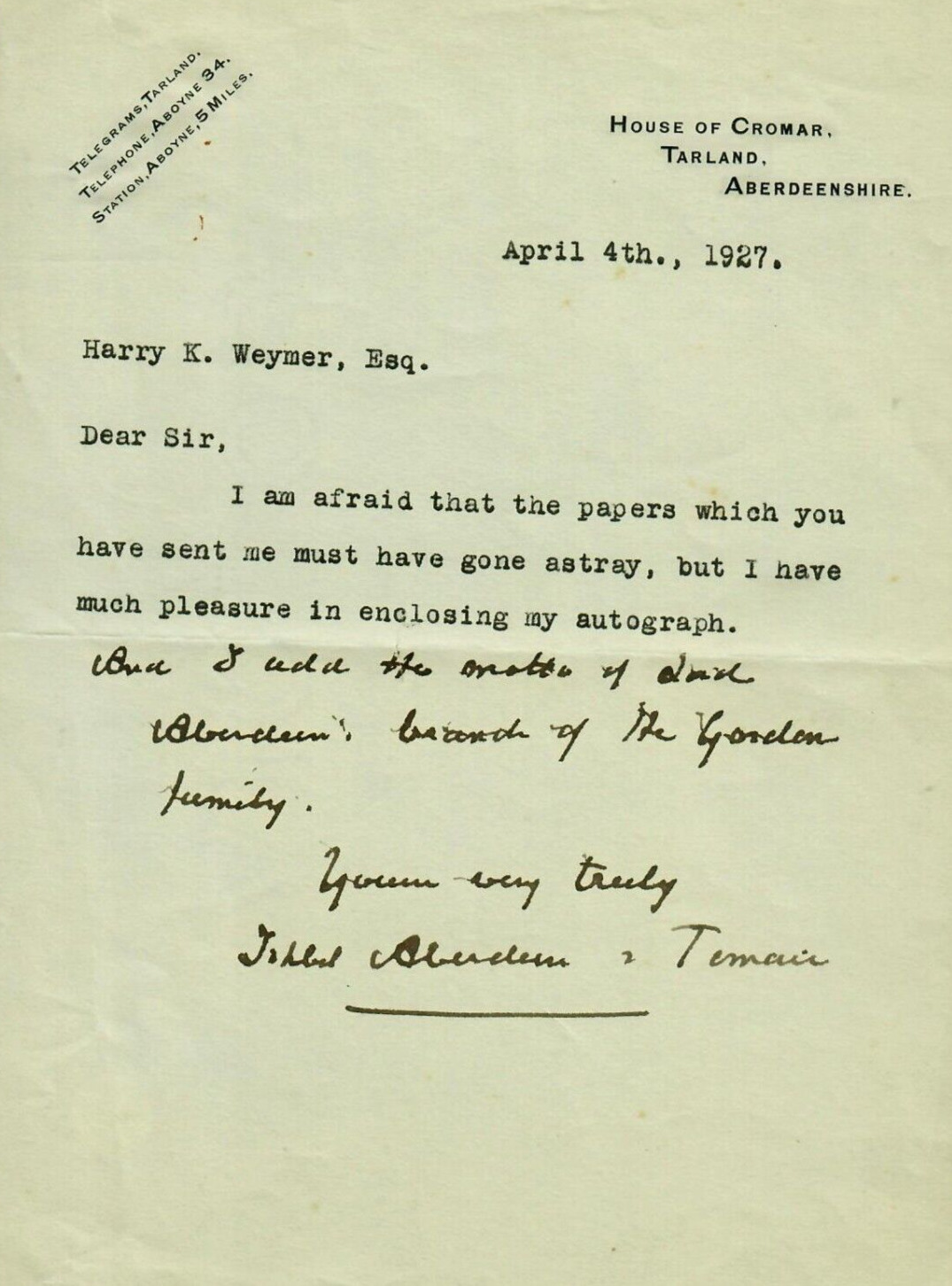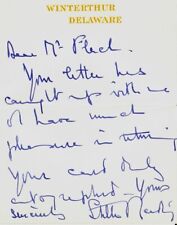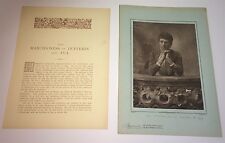|

On eBay Now...
RARE \"Marchioness of Aberdeen\" Ishbel Maria Hamilton-Gordon Hand Signed TLS For Sale

When you click on links to various merchants on this site and make a purchase, this can result in this site earning a commission. Affiliate programs and affiliations include, but are not limited to, the eBay Partner Network.

RARE \"Marchioness of Aberdeen\" Ishbel Maria Hamilton-Gordon Hand Signed TLS:
$489.99
Up for sale a VERY RARE! "Marchioness of Aberdeen" Ishbel Maria Hamilton-Gordon Hand Signed TLS With Hand Written Note Dated 1927.
ES-4674E Ishbel Maria Hamilton-Gordon, Marchioness of Aberdeen and Temair, GBE (née Isabel Maria Marjoribanks[a]; 15 March 1857 – 18 April 1939) was a British author, philanthropist, and an advocate of women's interests. As the wife of John Hamilton-Gordon, 1st Marquess of Aberdeen and Temair, she was viceregal consort of Canada from 1893 to 1898 and of Ireland from 1906-1915. Born in London, Marjoribanks was the third daughter of the 1st Baron Tweedmouth and Isabella Weir-Hogg (daughter of Sir James Weir Hogg). She received a well-rounded education in English, French, mathematics, history, and geography, and was such a good student that her teacher recommended she attend college. However, Lady Aberdeen's father shared the widely held opinion that university was no place for a woman. Instead, her education continued at home at her parents’ social events, where she met the famous politicians of the day. This experience helped prepare her for a lifetime of political involvement. Isabel became an evangelical at an early age, believing like many Victorians in a life dedicated to good works, as well as social and moral reform. After a six-year acquaintance, she married John Campbell Hamilton-Gordon, the 7th Earl of Aberdeen (later the 1st Marquess of Aberdeen and Temair), on 7 November 1877 in St. George's Church, St. George Street, Hanover Square, London. The couple had four surviving children: George (1879), Marjorie (1880), Dudley (1883), and Archibald (1884). Lady Aberdeen's daughter has eloquently written that "Ishbel interpreted the duty of wife as one who not only provided for her husband a serene background in private life, but as one who also thought and fought for him in all his affairs." Lord Aberdeen was a Liberal and a member of the House of Lords, and Lady Aberdeen supported him by hosting social events. An intelligent and determined woman, she soon established her own political life as an activist. Because of political obligations, the family divided their time between London and their Scottish estate in Aberdeenshire. They called their home Haddo House, and it was here that Lady Aberdeen began her involvement with social reforms. She organized a Household Club that held classes for servants to learn singing, carving, reading, and other activities. The Aberdeens often attended their servants’ evening socials and meetings, and in London society it was rumoured that they had even dined together. They also funded a local school and hospital – healthcare was a cause that Lady Aberdeen supported throughout her life. Lady Aberdeen's influence also extended beyond her country estate. She established the Onwards and Upward Association, which provided servant girls with postal courses on topics ranging from geography to literature to domestic science. This program spread from Aberdeenshire to include thousands of servants.[8] In 1883 she became the first president of the Ladies’ Union of Aberdeen, an organization that focused on the well-being of young women living in cities. An Emigration Committee chose suitable women and sponsored them to move to the colonies, specially Canada. Lady Aberdeen was also the head of the Women's Liberal Federation, which advocated for women's suffrage. In 1893, Lord Aberdeen was appointed the Governor General of Canada, a post he would occupy until 1898. The Aberdeens were no strangers to the country, as they had visited several times before; during their cross-Canada tour of 1890 they had even purchased a homestead in British Columbia. On that same visit they crossed the prairies, and Lady Aberdeen was struck by the difficult and isolated lifestyle of pioneers. She subsequently founded the Aberdeen Association for Distribution of Good Literature to Settlers in the West, which sent settlers packages of books and magazines. Lady Aberdeen was dedicated to her role as Governor General's wife (Viceregal consort of Canada). She hosted many popular social events, such as winter festivals and costume balls, and was more politically involved than her predecessors. She travelled extensively, attending events and collecting information for her husband. She regularly offered him advice, and in fact newspapers commented (sometimes critically) that it appeared she held the power in their relationship. In 1893, the year she arrived in Canada, Lady Aberdeen was named the first president of the International Council of Women, an organization that campaigns for women's rights. Consequently, she organized the National Council of Women of Canada and traveled the country establishing local branches. One of the activists she worked with was Adelaide Hoodless, who went on to found the Women's Institute. Lady Aberdeen was the first sponsor of the Women's Art Association of Canada, founded in 1892.[16] Yet another of her endeavours was the May Court Club, an association that enabled well-off young women to do charitable work. A key organization that she helped establish is the Victorian Order of Nurses, which aimed to give women better training and a higher salary so they could provide services to rural and disadvantaged populations. Lady Aberdeen and the group's supporters had to overcome resistance from the medical community before receiving the organization's royal charter in 1898. That same year, Lord and Lady Aberdeen returned to England. Lord Aberdeen belonged to the Liberal Party, and when it regained power in parliament in 1906 he was named the Lord Lieutenant of Ireland for the second time. He had previously been Lord Lieutenant, or viceroy, for approximately six months in 1886. True to her nature, Lady Aberdeen identified herself with the cause of the Irish people and contributed to Lord Aberdeen's success over the course of his six months in office.[18] During that time, Lady Aberdeen had promoted Irish crafts and became chairman of the Association of Irish Industries. Their second term in Ireland lasted from 1906 to 1915, and this time she focused on healthcare and social well-being. Lady Aberdeen was involved with medical organizations like the Women's National Health Association of Ireland that were dedicated to treating and preventing tuberculosis and improving children's health. Her name lives on in Lady Ishbel Avenue, part of the former Purdysburn Fever Hospital site in south Belfast. In 1911 she served as the first president of the Housing and Town Planning Association of Ireland, advocating for better housing and public spaces to address the prevalent poverty. Lady Aberdeen's Cottages in Mullingar are named after her. Although she had been quite popular during her first stint in Ireland, she faced a different reception upon her return. By 1906 nationalist sentiment had increased significantly in Ireland, and her ties to Britain were held against her. Furthermore, her determination to have her way meant that she was not always sensitive to the Irish perspective.


RARE "Marchioness of Aberdeen" Ishbel Maria Hamilton-Gordon Hand Signed TLS $489.99

RARE "Marchioness of Ripon" Gladys Robinson Clipped Signature COA $489.99

RARE "Marchioness of Reading" Stella Isaacs Hand Written Letter COA $489.99

RARE "Marchioness of Reading" Stella Isaacs Hand Signed 3X5.5 Card COA $349.99

RARE "Marchioness of Reading" Stella Isaacs Hand Signed Card COA $349.99

Rare Large Antique Lovely Victorian Portrait Marchioness of Dufferin & Ava Photo $46.79
|